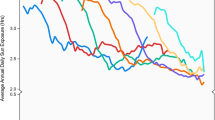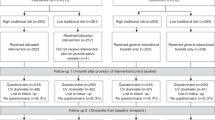Abstract
This paper analyzes the extent of offsetting behavior using survey data on risk beliefs about skin cancer and precautionary actions that people can take to avoid this disease. The perspective taken is that, at conception, people are "installed" with differing genetic characteristics, such as skin type and complexion, which affect the likelihood of contracting skin cancer. The main issue addressed deals with how people's risk beliefs respond to the "safety features" reflected in their own genetic characteristics. Empirical results presented suggest that precautions against solar radiation exposure are chosen so as to partially offset genetic skin cancer protection.
Similar content being viewed by others
References
Amemiya, Takeshi. (1978). “The Estimation of a Simultaneous Equation Generalized Probit Model,” Econometrica 46, 1193–1205.
Becker, Gary S. (1965). “A Theory of the Allocation of Time,” Economic Journal 75, 493–517.
Bernknopf, Richard L., David S. Brookshire, and Mark A. Thayer. (1990). “Earthquake and Volcano Hazard Notice: An Economic Evaluation of Changes—Risk Perception,” Journal of Environmental Economics and Management 18, 35–49.
Blomquist, Glenn C. (1988). The Regulation of Motor Vehicle and Traffic Safety. Kluwer Academic, Boston.
Blomquist, Glenn C. (1991). “Motorist Use of Safety Equipment: Expected Benefits or Risk Incompetence?” Journal of Risk and Uncertainty4, 135–52.
Chirinko, Robert S., and E.P. Harper, Jr. (1993). “Buckle Up or Slow Down? New Estimates of Offsetting Behavior and Their Implications for Automobile Safety Regulation,” Journal of Policy Analysis and Management 12, 270–296.
Courant, Paul N., and Richard C. Porter. (1981). “Averting Expenditure and the Cost of Pollution,” Journal of Environmental Economics and Management 8, 321–29.
Davidson, Russel, and James G. MacKinnon. (1993). Estimation and Inference in Econometrics. Oxford University Press, New York.
Dickie, Mark, and Shelby Gerking. (1991). “Valuing Reduced Morbidity: A Household Production Approach,” Southern Economic Journal 57, 967–83.
Dickie, Mark, and Shelby Gerking. (1996). “Formation of Risk Beliefs, Joint Production, and Willingness to Pay to Avoid Skin Cancer,” Review of Economics and Statistics 78, 451–63.
Doyle, James K. et al. (1991). “Protective Responses to Household Risk: A Case Study of Radon Mitigation,” Risk Analysis 11, 121–34.
Evans, William N., and John D. Graham. (1991). “Risk Reduction or Risk Compensation? The Case of Mandatory Seat-Belt Use Laws,” Journal of Risk and Uncertainty 4, 61–74.
Evans, William N., and John D. Graham. (1990). “An Estimate of the Lifesaving Benefit of Child Restraint Use Legislation,” Journal of Health Economics 9, 121–42.
Farrell, Phillip, and Victor R. Fuchs. (1982). “Schooling and Health: The Cigarette Connection,” Journal of Health Economics 1, 217–30.
Gallagher, Richard P. et al. (1995a). “Sunlight Exposure, Pigmentary Factors, and Risk of Nonmelanocytic Skin Cancer,” Archives of Dermatology 131, 157–63.
Gallagher, Richard P. et al. (1995b). “Sunlight Exposure, Pigmentation Factors, and Risk of Nonmelanocytic Skin Cancer: Squamous Cell Carcinoma,” Archives of Dermatology 131, 164–169.
Gerking, Shelby, Menno de Haan, and William D. Schulze. (1988). “The Marginal Value of Job Safety: A Contingent Valuation Study,” Journal of Risk and Uncertainty 1, 185–99.
Greene, William H. (1993). Econometric Analysis, Prentice-Hall, Englewood Cliffs, New Jersey.
Grossman, Michael. (1975). “The Correlation Between Health and Schooling,” In Nestor E. Terleckyj ed., Household Production and Consumption Columbia University Press, New York.
Johnson, F. Reed, and Ralph A. Luken. (1987). “Radon Risk Information and Voluntary Protection: Evidence from a Natural Experiment,” Risk Analysis 7, 97–107.
Keeler, Theodore E. (1994). “Highway Safety, Economic Behavior and Driving Environment,” American Economic Review 84, 684–93.
Lichtenstein, Sarah et al. (1978). “Judged Frequency of Lethal Events,” Journal of Experimental Psychology: Human Learning and Memory 4, 551–578.
Peltzman, Sam. (1975). “The Effect of Automobile Safety Regulation,” Journal of Political Economy 83, 677–725.
Smith, V. Kerry, William H. Desvousges, and J. Payne. (1995). “Do Risk Information Programs Promote Mitigating Behavior?” Journal of Risk and Uncertainty.
Smith, V. Kerry, and F. Reed Johnson. (1988). “How Do Risk Perception Respond to Information? The Case of Radon,” Review of Economics and Statistics 70, 1–8.
Stewart, Mark B. (1983). “On Least Squares Estimation When the Dependent Variable is Grouped,” Review of Economic Studies 50, 737–753.
Traynor, Thomas L. (1993). “The Peltzman Hypothesis Revisited: An Isolated Evaluation of Offsetting Driver Behavior,” Journal of Risk and Uncertainty 7, 237–47.
Viscusi, W. Kip. (1984). “The Lulling Effect: The Impact of Child-Restraint Packaging on Aspirin and Analgesic Ingestion,” American Economic Review 74, 324–27.
Viscusi, W. Kip. (1985). “A Bayesian Perspective on Biases in Risk Perceptions,” Economic Letters 17, 59–62.
Viscusi, W. Kip. (1985). “Consumer Behavior and the Safety Effects of Product Safety Regulation,” Journal of Law and Economics 28, 527–54.
Viscusi, W. Kip. (1990). “Do Smokers Underestimate Risks?” Journal of Political Economy 98, 1253–69.
Viscusi, W. Kip. (1991). “Age Variation in Risk Perception and Smoking Decisions,” Review of Economics and Statistics 73, 577–89.
Viscusi, W. Kip, and Gerald O. Cavallo. (1994). “The Effect of Product Safety Regulation on Safety Precautions,” Risk Analysis 14, 917–29.
Viscusi, W. Kip, and William N. Evans. (1990). “Utility Functions that Depend on Health Status: Estimates and Economic Implications,” American Economic Review 80, 353–74.
Viscusi, W. Kip, and Wesley A. Magat. (1987). Learning About Risk, Harvard University Press: Cambridge, Massachusetts.
Viscusi, W. Kip, Wesley A. Magat, and Joel Huber. (1987). “An Investigation of the Rationality of Consumer Valuation of Multiple Health Responses,” Rand Journal of Economics, 18, 465–79.
Wilde, Gerald J. S. (1982). “Critical Issues in Risk Homeostatis Theory.” Risk Analysis 2, 249–58.
Wilde, Gerald J. S. (1982). “The Theory of Risk Homeostatis: Implications for Safety and Health,” Risk Analysis 2, 209–25.
Author information
Authors and Affiliations
Rights and permissions
About this article
Cite this article
DICKIE, M., GERKING, S. Genetic Risk Factors and Offsetting Behavior: The Case of Skin Cancer. Journal of Risk and Uncertainty 15, 81–97 (1997). https://doi.org/10.1023/A:1007789921003
Issue Date:
DOI: https://doi.org/10.1023/A:1007789921003




